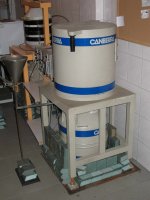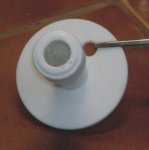Radioactivity Measurements Laboratory
Using Pb-210
The technique of 210Pb measurement
Measurements of 210Pb activity are done independently by alpha and gamma ray spectrometry methods.

The gamma ray spectrometry relies on the measurements of gamma photons emitted by 210Pb, 214Pb and 214Bi isotopes. Analysis of the 210Pb gamma spectrum line yields information about total activity of lead 210, while the assessed activity of 214Pb and 214Bi equals to the activity of autigenic 210Pb.
Small masses of samples and a low energy of gamma photons emitted by 210Pb (E210Pb = 46.5 keV) required the utilisation of a thin-wall well type germanium detector. The detector used is 45 mm high and 46 mm in diameter; the well is Ø = 8 x 35.5 mm. The detector's well contains a portion of sediment of precisely measured mass (about 1.2 g). Each sample was measured for not less than 24 hours. The activities of 210Pb, 214Pb and 214Bi were calculated by analyses of appropriate gamma spectrum lines in the sample and standard spectra. The activity of 210Pb assessed by gamma measurements is again the total activity of this isotope. Because a secular equilibrium may be assumed in this part of the series, activities of 214Pb and 214Bi isotopes are equal to the activity of autigenic lead.
The alpha ray spectrometry method. In 1997, a complete system for determination of 210Pb concentration in sediments was built and tested in our laboratory. The concentration of 210Pb is derived from the measurement of alpha activity of 210Po which is in radioactive equilibrium with 210Pb. A sample for alpha measurement has a form of a thin layer of polonium extracted from the sediment and deposited on a silver disc (Flynn, 1968). Initial dry mass of the sample is 1-2g. The sample is treated with hot 65% nitric acid (10-20 ml, 95°C, 60 min). In nitric acid, polonium is extracted from the sediment. The extraction is continued at room temperature during the following 24h, and hence the sediment is separated from the solution by centrifugation (6000 rpm for 10 min). The solution is collected in a teflon vial, while the remaining sediment is rinsed with 65% nitric acid and centrifuged again. Both aliquots of the solution are collected in one teflon vial. After adding 30ml 30% H2O2 (to oxidise the organic matter) the solution is evaporated. The evaporite is dissolved in 10ml portions of 35-38% HCl and evaporated again. After a few dissolution/evaporation steps, nitric acid is fully replaced with hydrochloric acid.

Polonium is deposited on silver from the 0.5M solution of HCl, containing 0.4g of hydroxyloamine and 0.4g of sodium citrate, at 90°C. Silver disc with a diameter of 20 mm is placed in a special holder which enables polonium deposition on one side of the disc. To speed up the deposition, a magnetic stirrer is placed below the disc. After ca. 3h of deposition, the disc surface is covered with a white coating. To control the efficiency of deposition and alpha detection, a portion of HCl containing a known amount of 208Po (manufactured by AERE Harwell, United Kingdom) is added before extraction of polonium from the sediment. 208Po does not occur in natural environment. Efficiency of deposition of 30-80% is commonly achieved.
Alpha activity is measured with a spectrometer Canberra model 7401, with a surface-barrier Si semiconductor detector. The sensitive area of the detector is 300 mm2 and its energy resolution is ca. 20 keV. This enables a very good separation of peaks from 210Po (E = 5.308 MeV) and 208Po (E = 5.105 MeV). Absolute activities of both isotopes are rather low and to obtain sufficient precision, one measurement lasts a few thounsand minutes.
As the half lifes of both polonium isotopes are quite short (T208=2.898 years, T210=138.4 days), results of calculations are corrected for radioactive decay of 208Po since the moment of its calibration, and decay of 210Pb since the moment of polonium extraction from sediments.



